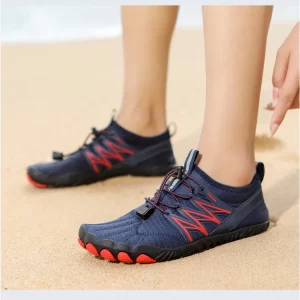The site is under construction. Please visit us shortly
Barefoot shoes and minimalist shoes are terms often used interchangeably, but there are subtle differences between them. Both types of footwear aim to provide a more natural and minimalistic feel compared to traditional shoes with thick, supportive soles. Here’s a breakdown of the key distinctions:
Zero Drop: Barefoot shoes typically have a zero-drop design, meaning the heel and forefoot are at the same level, promoting a more natural foot position.
Thin Soles: These shoes have thin soles that allow for a greater sense of ground contact and proprioception, helping the wearer feel the terrain underfoot.
Wide Toe Box: Barefoot shoes often have a wider toe box, allowing the toes to splay naturally. This can enhance stability and comfort.
Flexibility: They are designed to be flexible, allowing the foot to move more freely and naturally.
Minimal Cushioning: Barefoot shoes usually have minimal to no cushioning, encouraging the foot’s natural shock absorption.
Low Drop: While still promoting a lower heel-to-toe drop than traditional shoes, minimalist shoes may not necessarily have a zero-drop design.
Moderate Sole Thickness: Minimalist shoes may have slightly thicker soles compared to barefoot shoes, providing a compromise between natural feel and some level of protection.
Varied Toe Box: The toe box in minimalist shoes might be slightly narrower than in barefoot shoes, although it is still broader than many traditional shoe designs.
Flexibility: Like barefoot shoes, minimalist shoes prioritize flexibility but may not be as flexible as some barefoot models.
Some Cushioning: Minimalist shoes may include a minimal amount of cushioning for comfort, but it is usually less than what is found in traditional shoes.
In summary, barefoot shoes tend to be a subset of minimalist shoes that specifically emphasize a zero-drop design, thin soles, and a wide toe box. Minimalist shoes, on the other hand, encompass a broader category that includes a range of designs with varying degrees of heel drop, sole thickness, and toe box width. When choosing between them, it’s essential to consider individual preferences, foot anatomy, and the intended use of the footwear.






